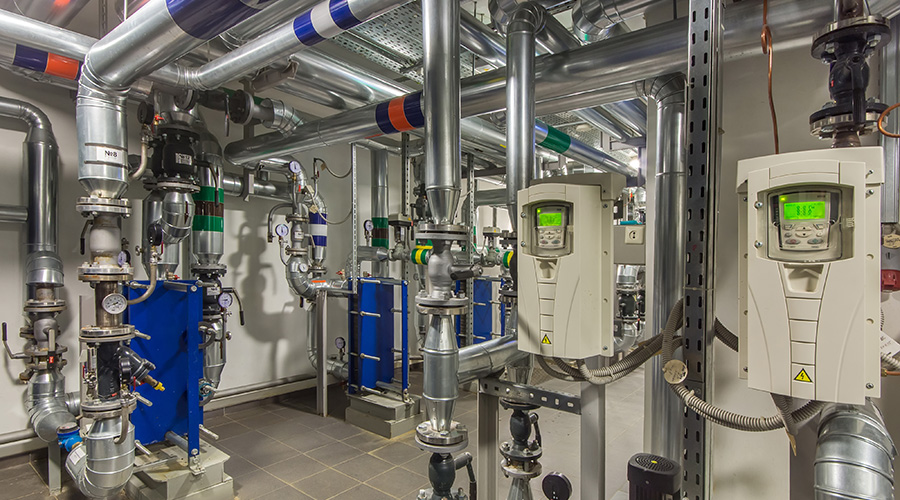The Benefits of VFDs In HVAC Systems
One of the most successful energy management tools ever applied to building HVAC systems is the variable frequency drive (VFD). For more than 20 years, VFDs have successfully been installed on fan and pump motors in a range of variable load applications. Energy savings vary from 35 to 50 percent over conventional constant speed applications, resulting in a return on investment of six months to two years.
While the number of applications suitable for early generation drives was limited based on the horsepower of the motor, today's drives can be installed in practically any HVAC application found in commercial and institutional buildings. Systems can be operated at higher voltages than those used by earlier generations, resulting in off the shelf systems for motors up to 500 horsepower.
Early generation systems also suffered from low power factor. Low power factor robs the facility of electrical distribution capacity and can result in cost penalties imposed by electrical utility companies. Today's systems operate at a nearly constant power factor over the entire speed range of the motor.
Another problem that has been corrected by today's systems is operational noise. As the output frequency of the drives decreased in response to the load, vibrations induced in the motor laminations generated noise that was easily transmitted through the motor mounts to the building interior. Today's drives operate at higher frequencies, resulting in the associated noise being above the audible range.
And VFDs continue to evolve. From numerous system benefits to an increasing range of available applications, VFDs are proving to be ever more useful and powerful.
The Heart of VFDs
Most conventional building HVAC applications are designed to operate fans and pumps at a constant speed. Building loads, however, are anything but constant. In a conventional system, some form of mechanical throttling can be used to reduce water or air flow in the system. The drive motor, however, continues to operate at full speed, using nearly the same amount of energy regardless of the heating or cooling load on the system. While mechanical throttling can provide a good level of control, it is not very efficient. VFDs offer an effective and efficient alternative.
Three factors work together to improve operating efficiency with VFDs:
1. Operating at less than full load. Building systems are sized for peak load conditions. In typical applications, peak load conditions occur between 1 and 5 percent of the annual operating hours. This means that pump and fan motors are using more energy than necessary 95 to 99 percent of their operating hours.
2. Oversized system designs. Designing for peak load oversizes the system for most operating hours. This condition is further compounded by the practice of oversizing the system design to allow for underestimated and unexpected loads as well as future loads that might result from changes in how the building space is used.
3. Motor energy use is a function of speed. The most commonly used motor in building HVAC systems is the induction motor. With induction motors, the power drawn by the motor varies with the cube of the motor's speed. This means that if the motor can be slowed by 25 percent of its normal operating speed, its energy use is reduced by nearly 60 percent. At a 50 percent reduction in speed, energy use is reduced by nearly 90 percent.
The installation of a VFD in an HVAC application addresses the inefficiencies introduced by the first two factors, while producing the energy savings made possible by the third. The VFD accomplishes this by converting 60 cycle line current to direct current, then to an output that varies in voltage and frequency based on the load placed on the system. As the system load decreases, the VFD's controller reduces the motor's operating speed so that the flow rate through the system meets but does not exceed the load requirements.
VFD Benefits
The most significant benefit to using a VFD is energy savings. By matching system capacity to the actual load throughout the entire year, major savings in system motor energy use are achieved.
Another benefit of the units is reduced wear and tear on the motors. When an induction motor is started, it draws a much higher current than during normal operation. This inrush current can be three to ten times the full-load operating current for the motor, generating both heat and stress in the motor's windings and other components. In motors that start and stop frequently, this contributes to early motor failures.
In contrast, when a motor connected to a VFD is started, the VFD applies a very low frequency and low voltage to the motor. Both are gradually ramped up at a controlled rate to normal operating conditions, extending motor life.
VFDs also provide more precise levels of control of applications. For example, high-rise buildings use a booster pump system on the domestic water supply to maintain adequate water pressure at all levels within the building. Conventional pump controls in this type of application can maintain the pressure within a certain range, but a VFD-based system can maintain more precise control over a wider range of flow rates, while reducing energy requirements and pump wear.
Related Topics:












